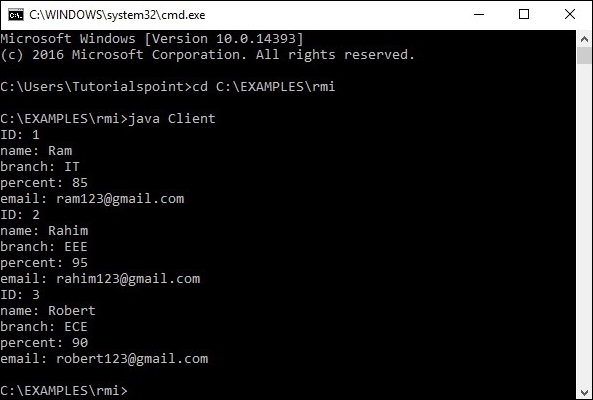- PHP 7-快速指南(1)
- PHP 7-快速指南
- Java RMI应用程序
- Java RMI应用程序(1)
- Java RMI教程(1)
- Java RMI教程
- Java RMI-简介(1)
- Java RMI-简介
- AJAX-快速指南(1)
- AJAX-快速指南
- 讨论Java RMI(1)
- 讨论Java RMI
- JDBC-快速指南(1)
- JDBC-快速指南
- 移动计算-快速指南(1)
- 移动计算-快速指南
- 区块链-快速指南
- 敏捷-快速指南(1)
- 敏捷-快速指南
- Underscore.JS-快速指南
- Underscore.JS-快速指南(1)
- Java RMI-数据库应用程序(1)
- Java RMI-数据库应用程序
- Bulma-快速指南
- Bulma-快速指南(1)
- Pytest-快速指南
- DLL-快速指南
- DLL-快速指南(1)
- Splunk-快速指南
📅 最后修改于: 2020-11-15 03:22:45 🧑 作者: Mango
RMI代表远程方法调用。它是一种允许驻留在一个系统(JVM)中的对象访问/调用在另一个JVM上运行的对象的机制。
RMI用于构建分布式应用程序;它提供Java程序之间的远程通信。它在包java.rmi中提供。
RMI应用程序的体系结构
在RMI应用程序中,我们编写两个程序,一个服务器程序(驻留在服务器上)和一个客户端程序(驻留在客户端上)。
-
在服务器程序内部,将创建一个远程对象,并使该对象的引用可用于客户端(使用注册表)。
-
客户端程序在服务器上请求远程对象,并尝试调用其方法。
下图显示了RMI应用程序的体系结构。
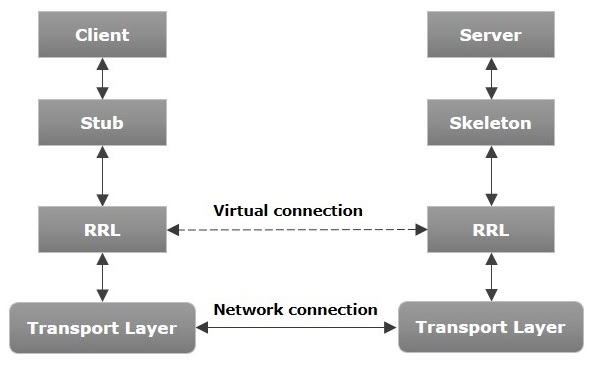
现在让我们讨论该体系结构的组件。
-
传输层-此层连接客户端和服务器。它管理现有连接并建立新连接。
-
存根-存根是客户端上远程对象的表示(代理)。它位于客户端系统中;它充当客户端程序的网关。
-
骨架-这是位于服务器端的对象。存根与此骨架进行通信,以将请求传递给远程对象。
-
RRL(远程参考层) -它是管理客户端对远程对象所做的参考的层。
RMI应用程序的工作
以下几点总结了RMI应用程序的工作方式-
-
当客户端调用远程对象时,存根会接收到该对象,该存根最终将该请求传递给RRL。
-
当客户端RRL收到请求时,它将调用对象remoteRef的称为invoke()的方法。它将请求传递到服务器端的RRL。
-
服务器端的RRL将请求传递给骨架(服务器上的代理),该骨架最终在服务器上调用所需的对象。
-
结果一路传递回客户端。
编组和拆组
每当客户端调用在远程对象上接受参数的方法时,这些参数就会捆绑成一条消息,然后再通过网络发送。这些参数可以是原始类型或对象。如果是原始类型,则将参数放在一起并在其上附加标题。如果参数是对象,则将其序列化。此过程称为编组。
在服务器端,打包的参数将取消捆绑,然后调用所需的方法。此过程称为解组。
RMI注册中心
RMI注册表是一个放置所有服务器对象的名称空间。每次服务器创建一个对象时,它将向RMIregistry注册该对象(使用bind()或reBind()方法)。这些是使用称为绑定名的唯一名称注册的。
要调用远程对象,客户端需要该对象的引用。那时,客户端使用其绑定名称(使用lookup()方法)从注册表中获取对象。
下图说明了整个过程-
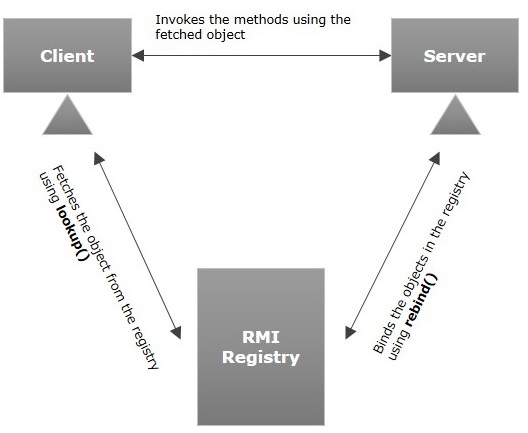
RMI的目标
以下是RMI的目标-
- 为了最小化应用程序的复杂性。
- 为了保持类型安全。
- 分布式垃圾回收。
- 最小化使用本地对象和远程对象之间的差异。
Java RMI应用程序
要编写RMI Java应用程序,您必须遵循以下步骤-
- 定义远程接口
- 开发实现类(远程对象)
- 开发服务器程序
- 开发客户程序
- 编译应用
- 执行申请
定义远程接口
远程接口提供了特定远程对象的所有方法的描述。客户端与此远程接口进行通信。
创建一个远程接口-
-
创建一个接口,该接口扩展了属于该程序包的预定义接口Remote 。
-
声明客户端可以在此接口中调用的所有业务方法。
-
由于在远程调用期间可能会出现网络问题,因此可能会发生一个名为RemoteException的异常。丢它。
以下是远程接口的示例。在这里,我们定义了一个名称为Hello的接口,它具有一个名为printMsg()的方法。
import java.rmi.Remote;
import java.rmi.RemoteException;
// Creating Remote interface for our application
public interface Hello extends Remote {
void printMsg() throws RemoteException;
}
开发实现类(远程对象)
我们需要实现在先前步骤中创建的远程接口。 (我们可以单独编写一个实现类,也可以直接使服务器程序实现此接口。)
开发一个实现类-
- 实现上一步中创建的接口。
- 提供对远程接口的所有抽象方法的实现。
以下是一个实现类。在这里,我们创建了一个名为ImplExample的类,并实现了在上一步中创建的Hello接口,并为该方法提供了正文,该方法可以打印消息。
// Implementing the remote interface
public class ImplExample implements Hello {
// Implementing the interface method
public void printMsg() {
System.out.println("This is an example RMI program");
}
}
开发服务器程序
RMI服务器程序应实现远程接口或扩展实现类。在这里,我们应该创建一个远程对象并将其绑定到RMIregistry 。
开发服务器程序-
-
在要从中调用远程对象的位置创建一个客户端类。
-
通过实例化实现类创建一个远程对象,如下所示。
-
使用名为UnicastRemoteObject的类的方法exportObject()导出远程对象,该类属于包java.rmi.server 。
-
使用属于包java.rmi.registry的LocateRegistry类的getRegistry ()方法获取RMI注册表。
-
使用名为Registry的类的bind()方法将创建的远程对象绑定到注册表。向此方法传递代表绑定名称和导出对象的字符串作为参数。
以下是RMI服务器程序的示例。
import java.rmi.registry.Registry;
import java.rmi.registry.LocateRegistry;
import java.rmi.RemoteException;
import java.rmi.server.UnicastRemoteObject;
public class Server extends ImplExample {
public Server() {}
public static void main(String args[]) {
try {
// Instantiating the implementation class
ImplExample obj = new ImplExample();
// Exporting the object of implementation class
// (here we are exporting the remote object to the stub)
Hello stub = (Hello) UnicastRemoteObject.exportObject(obj, 0);
// Binding the remote object (stub) in the registry
Registry registry = LocateRegistry.getRegistry();
registry.bind("Hello", stub);
System.err.println("Server ready");
} catch (Exception e) {
System.err.println("Server exception: " + e.toString());
e.printStackTrace();
}
}
}
开发客户计划
在其中编写一个客户端程序,获取远程对象并使用该对象调用所需的方法。
开发客户端程序-
-
在您打算从中调用远程对象的位置创建一个客户端类。
-
使用属于包java.rmi.registry的LocateRegistry类的getRegistry ()方法获取RMI注册表。
-
使用属于包java.rmi.registry的Registry类的方法lookup()从注册表中获取对象。
对于此方法,您需要传递一个表示绑定名称的字符串值作为参数。这将返回您的远程对象。
-
lookup()返回一个远程类型的对象,将其向下转换为Hello类型。
-
最后,使用获取的远程对象调用所需的方法。
以下是RMI客户端程序的示例。
import java.rmi.registry.LocateRegistry;
import java.rmi.registry.Registry;
public class Client {
private Client() {}
public static void main(String[] args) {
try {
// Getting the registry
Registry registry = LocateRegistry.getRegistry(null);
// Looking up the registry for the remote object
Hello stub = (Hello) registry.lookup("Hello");
// Calling the remote method using the obtained object
stub.printMsg();
// System.out.println("Remote method invoked");
} catch (Exception e) {
System.err.println("Client exception: " + e.toString());
e.printStackTrace();
}
}
}
编译应用
编译应用程序-
- 编译远程接口。
- 编译实现类。
- 编译服务器程序。
- 编译客户端程序。
要么,
打开存储所有程序的文件夹,并编译所有Java文件,如下所示。
Javac *.java
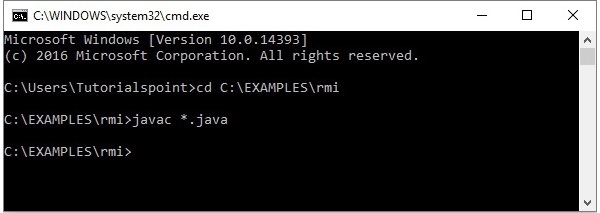
执行申请
步骤1-使用以下命令启动rmi注册表。
start rmiregistry
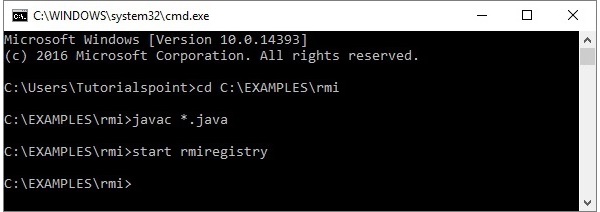
如下所示,这将在另一个窗口上启动rmi注册表。

步骤2-运行服务器类文件,如下所示。
Java Server

步骤3-运行客户端类文件,如下所示。
java Client

验证-一旦启动客户端,您将在服务器中看到以下输出。
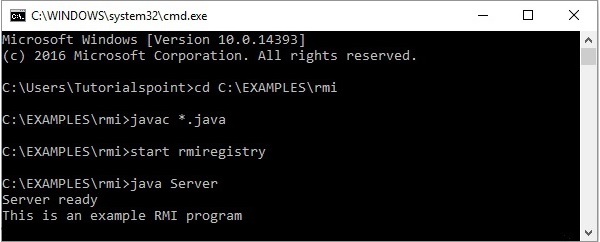
Java RMI-GUI应用程序
在上一章中,我们创建了一个示例RMI应用程序。在本章中,我们将说明如何创建一个RMI应用程序,其中客户端调用一个显示GUI窗口(JavaFX)的方法。
定义远程接口
在这里,我们定义了一个名为Hello的远程接口,其中包含一个名为animation()的方法。
import java.rmi.Remote;
import java.rmi.RemoteException;
// Creating Remote interface for our application
public interface Hello extends Remote {
void animation() throws RemoteException;
}
开发实施类
在此应用程序的Implementation类(远程对象)中,我们试图使用JavaFX创建一个显示GUI内容的窗口。
import javafx.animation.RotateTransition;
import javafx.application.Application;
import javafx.event.EventHandler;
import javafx.scene.Group;
import javafx.scene.PerspectiveCamera;
import javafx.scene.Scene;
import javafx.scene.control.TextField;
import javafx.scene.input.KeyEvent;
import javafx.scene.paint.Color;
import javafx.scene.paint.PhongMaterial;
import javafx.scene.shape.Box;
import javafx.scene.text.Font;
import javafx.scene.text.FontWeight;
import javafx.scene.text.Text;
import javafx.scene.transform.Rotate;
import javafx.stage.Stage;
import javafx.util.Duration;
// Implementing the remote interface
public class FxSample extends Application implements Hello {
@Override
public void start(Stage stage) {
// Drawing a Box
Box box = new Box();
// Setting the properties of the Box
box.setWidth(150.0);
box.setHeight(150.0);
box.setDepth(100.0);
// Setting the position of the box
box.setTranslateX(350);
box.setTranslateY(150);
box.setTranslateZ(50);
// Setting the text
Text text = new Text(
"Type any letter to rotate the box, and click on the box to stop the rotation");
// Setting the font of the text
text.setFont(Font.font(null, FontWeight.BOLD, 15));
// Setting the color of the text
text.setFill(Color.CRIMSON);
// Setting the position of the text
text.setX(20);
text.setY(50);
// Setting the material of the box
PhongMaterial material = new PhongMaterial();
material.setDiffuseColor(Color.DARKSLATEBLUE);
// Setting the diffuse color material to box
box.setMaterial(material);
// Setting the rotation animation to the box
RotateTransition rotateTransition = new RotateTransition();
// Setting the duration for the transition
rotateTransition.setDuration(Duration.millis(1000));
// Setting the node for the transition
rotateTransition.setNode(box);
// Setting the axis of the rotation
rotateTransition.setAxis(Rotate.Y_AXIS);
// Setting the angle of the rotation
rotateTransition.setByAngle(360);
// Setting the cycle count for the transition
rotateTransition.setCycleCount(50);
// Setting auto reverse value to false
rotateTransition.setAutoReverse(false);
// Creating a text filed
TextField textField = new TextField();
// Setting the position of the text field
textField.setLayoutX(50);
textField.setLayoutY(100);
// Handling the key typed event
EventHandler eventHandlerTextField = new EventHandler() {
@Override
public void handle(KeyEvent event) {
// Playing the animation
rotateTransition.play();
}
};
// Adding an event handler to the text feld
textField.addEventHandler(KeyEvent.KEY_TYPED, eventHandlerTextField);
// Handling the mouse clicked event(on box)
EventHandler eventHandlerBox =
new EventHandler() {
@Override
public void handle(javafx.scene.input.MouseEvent e) {
rotateTransition.stop();
}
};
// Adding the event handler to the box
box.addEventHandler(javafx.scene.input.MouseEvent.MOUSE_CLICKED, eventHandlerBox);
// Creating a Group object
Group root = new Group(box, textField, text);
// Creating a scene object
Scene scene = new Scene(root, 600, 300);
// Setting camera
PerspectiveCamera camera = new PerspectiveCamera(false);
camera.setTranslateX(0);
camera.setTranslateY(0);
camera.setTranslateZ(0);
scene.setCamera(camera);
// Setting title to the Stage
stage.setTitle("Event Handlers Example");
// Adding scene to the stage
stage.setScene(scene);
// Displaying the contents of the stage
stage.show();
}
// Implementing the interface method
public void animation() {
launch();
}
}
服务器程序
RMI服务器程序应实现远程接口或扩展实现类。在这里,我们应该创建一个远程对象并将其绑定到RMIregistry 。
以下是此应用程序的服务器程序。在这里,我们将扩展上面创建的类,创建一个远程对象,并将其注册为具有绑定名称hello的RMI注册表。
import java.rmi.registry.Registry;
import java.rmi.registry.LocateRegistry;
import java.rmi.RemoteException;
import java.rmi.server.UnicastRemoteObject;
public class Server extends FxSample {
public Server() {}
public static void main(String args[]) {
try {
// Instantiating the implementation class
FxSample obj = new FxSample();
// Exporting the object of implementation class
// (here we are exporting the remote object to the stub)
Hello stub = (Hello) UnicastRemoteObject.exportObject(obj, 0);
// Binding the remote object (stub) in the registry
Registry registry = LocateRegistry.getRegistry();
registry.bind("Hello", stub);
System.err.println("Server ready");
} catch (Exception e) {
System.err.println("Server exception: " + e.toString());
e.printStackTrace();
}
}
}
客户程序
以下是此应用程序的客户端程序。在这里,我们获取远程对象并调用其名为animation()的方法。
import java.rmi.registry.LocateRegistry;
import java.rmi.registry.Registry;
public class Client {
private Client() {}
public static void main(String[] args) {
try {
// Getting the registry
Registry registry = LocateRegistry.getRegistry(null);
// Looking up the registry for the remote object
Hello stub = (Hello) registry.lookup("Hello");
// Calling the remote method using the obtained object
stub.animation();
System.out.println("Remote method invoked");
} catch (Exception e) {
System.err.println("Client exception: " + e.toString());
e.printStackTrace();
}
}
}
运行示例的步骤
以下是运行我们的RMI示例的步骤。
步骤1-打开存储所有程序的文件夹,并编译所有Java文件,如下所示。
Javac *.java
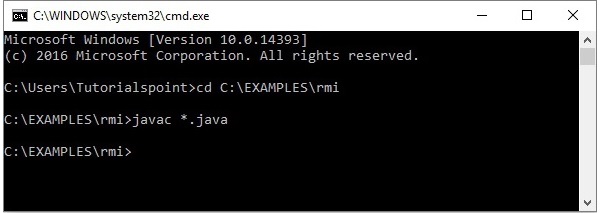
步骤2-使用以下命令启动rmi注册表。
start rmiregistry
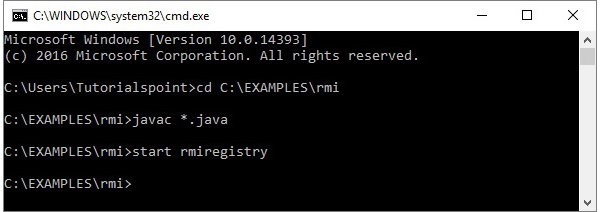
如下所示,这将在另一个窗口上启动rmi注册表。

步骤3-运行服务器类文件,如下所示。
Java Server

步骤4-运行客户端类文件,如下所示。
java Client

验证-一旦启动客户端,您将在服务器中看到以下输出。

Java RMI-数据库应用程序
在上一章中,我们创建了一个示例RMI应用程序,其中客户端调用一个显示GUI窗口(JavaFX)的方法。
在本章中,我们将以一个示例为例,说明客户端程序如何在服务器上的MySQL数据库中检索表的记录。
假设我们在数据库详细信息中有一个名为student_data的表,如下所示。
+----+--------+--------+------------+---------------------+
| ID | NAME | BRANCH | PERCENTAGE | EMAIL |
+----+--------+--------+------------+---------------------+
| 1 | Ram | IT | 85 | ram123@gmail.com |
| 2 | Rahim | EEE | 95 | rahim123@gmail.com |
| 3 | Robert | ECE | 90 | robert123@gmail.com |
+----+--------+--------+------------+---------------------+
假设用户名是myuser ,密码是password 。
创建学生班
如下所示,使用setter和getter方法创建一个Student类。
public class Student implements java.io.Serializable {
private int id, percent;
private String name, branch, email;
public int getId() {
return id;
}
public String getName() {
return name;
}
public String getBranch() {
return branch;
}
public int getPercent() {
return percent;
}
public String getEmail() {
return email;
}
public void setID(int id) {
this.id = id;
}
public void setName(String name) {
this.name = name;
}
public void setBranch(String branch) {
this.branch = branch;
}
public void setPercent(int percent) {
this.percent = percent;
}
public void setEmail(String email) {
this.email = email;
}
}
定义远程接口
定义远程接口。在这里,我们定义了一个名为Hello的远程接口,其中包含一个名为getStudents()的方法。此方法返回一个列表,其中包含Student类的对象。
import java.rmi.Remote;
import java.rmi.RemoteException;
import java.util.*;
// Creating Remote interface for our application
public interface Hello extends Remote {
public List getStudents() throws Exception;
}
开发实施类
创建一个类并实现上面创建的接口。
在这里,我们实现了Remote接口的getStudents()方法。调用此方法时,它将检索名为student_data的表的记录。使用其setter方法将这些值设置为Student类,将其添加到列表对象并返回该列表。
import java.sql.*;
import java.util.*;
// Implementing the remote interface
public class ImplExample implements Hello {
// Implementing the interface method
public List getStudents() throws Exception {
List list = new ArrayList();
// JDBC driver name and database URL
String JDBC_DRIVER = "com.mysql.jdbc.Driver";
String DB_URL = "jdbc:mysql://localhost:3306/details";
// Database credentials
String USER = "myuser";
String PASS = "password";
Connection conn = null;
Statement stmt = null;
//Register JDBC driver
Class.forName("com.mysql.jdbc.Driver");
//Open a connection
System.out.println("Connecting to a selected database...");
conn = DriverManager.getConnection(DB_URL, USER, PASS);
System.out.println("Connected database successfully...");
//Execute a query
System.out.println("Creating statement...");
stmt = conn.createStatement();
String sql = "SELECT * FROM student_data";
ResultSet rs = stmt.executeQuery(sql);
//Extract data from result set
while(rs.next()) {
// Retrieve by column name
int id = rs.getInt("id");
String name = rs.getString("name");
String branch = rs.getString("branch");
int percent = rs.getInt("percentage");
String email = rs.getString("email");
// Setting the values
Student student = new Student();
student.setID(id);
student.setName(name);
student.setBranch(branch);
student.setPercent(percent);
student.setEmail(email);
list.add(student);
}
rs.close();
return list;
}
}
服务器程序
RMI服务器程序应实现远程接口或扩展实现类。在这里,我们应该创建一个远程对象并将其绑定到RMI注册中心。
以下是此应用程序的服务器程序。在这里,我们将扩展上面创建的类,创建一个远程对象,并使用绑定名称hello将其注册到RMI注册表。
import java.rmi.registry.Registry;
import java.rmi.registry.LocateRegistry;
import java.rmi.RemoteException;
import java.rmi.server.UnicastRemoteObject;
public class Server extends ImplExample {
public Server() {}
public static void main(String args[]) {
try {
// Instantiating the implementation class
ImplExample obj = new ImplExample();
// Exporting the object of implementation class (
here we are exporting the remote object to the stub)
Hello stub = (Hello) UnicastRemoteObject.exportObject(obj, 0);
// Binding the remote object (stub) in the registry
Registry registry = LocateRegistry.getRegistry();
registry.bind("Hello", stub);
System.err.println("Server ready");
} catch (Exception e) {
System.err.println("Server exception: " + e.toString());
e.printStackTrace();
}
}
}
客户程序
以下是此应用程序的客户端程序。在这里,我们正在获取远程对象并调用名为getStudents()的方法。它从列表对象中检索表的记录并显示它们。
import java.rmi.registry.LocateRegistry;
import java.rmi.registry.Registry;
import java.util.*;
public class Client {
private Client() {}
public static void main(String[] args)throws Exception {
try {
// Getting the registry
Registry registry = LocateRegistry.getRegistry(null);
// Looking up the registry for the remote object
Hello stub = (Hello) registry.lookup("Hello");
// Calling the remote method using the obtained object
List list = (List)stub.getStudents();
for (Student s:list)v {
// System.out.println("bc "+s.getBranch());
System.out.println("ID: " + s.getId());
System.out.println("name: " + s.getName());
System.out.println("branch: " + s.getBranch());
System.out.println("percent: " + s.getPercent());
System.out.println("email: " + s.getEmail());
}
// System.out.println(list);
} catch (Exception e) {
System.err.println("Client exception: " + e.toString());
e.printStackTrace();
}
}
}
运行示例的步骤
以下是运行我们的RMI示例的步骤。
步骤1-打开存储所有程序的文件夹,并编译所有Java文件,如下所示。
Javac *.java
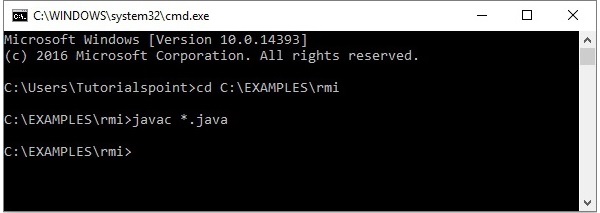
步骤2-使用以下命令启动rmi注册表。
start rmiregistry
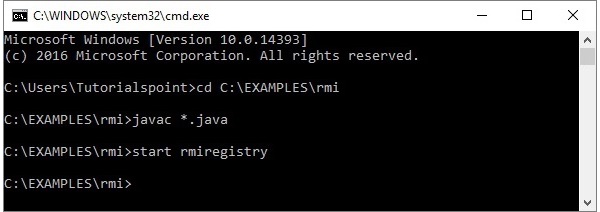
如下所示,这将在另一个窗口上启动rmi注册表。

步骤3-运行服务器类文件,如下所示。
Java Server

步骤4-运行客户端类文件,如下所示。
java Client
